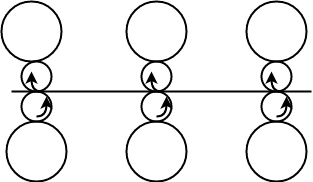This set of Engineering Materials & Metallurgy Multiple Choice Questions & Answers (MCQs) focuses on “Cryogenics, Hot and Cold Working of Metals”.
1. Cryogenics deal with temperatures around _________
a) -50oC
b) -90oC
c) -180oC
d) -250oC
View Answer
Explanation: Cryogenics is defined as the study of materials at a low temperature. This often stands at -150oC in general use but has a standard set by National Institute of Standards and Technology as -180oC. This comes into consideration due to the boiling point of gases.
2. What is the boiling point of nitrogen?
a) 20.27
b) 27.09
c) 77.36
d) 111.7
View Answer
Explanation: Cryogenics refers to the study and production of materials under low temperatures. The boiling points of cryogenic fluids like hydrogen, neon, nitrogen, and methane are 20.27K, 27.09K, 77.36K, and 111.7K in that order.
3. Liquid oxygen is produced by ____________ method.
a) Batch distillation
b) Steam distillation
c) Extractive distillation
d) Fractional distillation
View Answer
Explanation: Liquid oxygen (Lox) is a common cryogenic gas commonly used in aerospace and medical applications. It is formed from the oxygen in air by fractional distillation method.
4. What is the appearance of liquid nitrogen?
a) Yellow
b) Colorless
c) Bluish-gray
d) Black
View Answer
Explanation: Liquid nitrogen is a cryogenic liquid formed from nitrogen at low temperatures. It is a colorless liquid that results in brisk freezing.
5. How can cryogenic temperatures lower than 30,000K be measured?
a) Silicon diode
b) Calorimeter
c) Superconducting granules
d) Roton detector
View Answer
Explanation: Cryogenic particle detectors often operate around absolute zero temperature. Up to 30,000K, resistant thermometers like PT-100 sensor are used. Below this temperature, silicon diode is used for measurement of temperature.
6. Cold working is generally carried out __________
a) Below melting point
b) Above recrystallization temperature
c) At room temperature
d) Cryogenic temperature
View Answer
Explanation: Cold working is defined as the plastic deformation of a material which results in strain hardening. It usually occurs at room temperature. Hot working is generally carried out above recrystallization temperature but below its melting point.
7. How does hot working affect grain structure?
a) Refines it
b) Distorts it
c) Warps it
d) Has no effect
View Answer
Explanation: Although hot working refines the grain structure of the material, it does not improve its surface finish. Cold working, on the other hand, improves surface finish while distorting the grain structure.
8. Which of the following is an application of hot working?
a) Shapes the metal
b) Finishing
c) Thinning of material
d) Dimensional accuracy
View Answer
Explanation: Hot working of materials is done to help shape the metal and produce raw material for cold working. Cold working, on the other hand, is used for finishing, thinning, and improving mechanical properties while also improving dimensional accuracy of the metal.
9. Which of the following is a drawback of cold working?
a) Oxide formation
b) Surface scaling
c) Decarburization
d) Low ductility
View Answer
Explanation: When hot worked, surface scaling and decarburization of the material occurs, with the formation of oxide. On cold working, the cold worked part may experience strain hardening and less ductility.
10. Which of the following is a hot working process?
a) Stamping
b) Squeezing
c) Forging
d) Bending
View Answer
Explanation: Forging, pipe welding, and spinning are the most commonly employed hot working processes, whereas those of cold working include pressing and deep drawing, tamping, squeezing, bending, and shearing. Rolling and extrusion methods are common to both hot and cold working.
11. What is the hot rolling temperature of mild steel?
a) 200oC
b) 450oC
c) 1000oC
d) 1200oC
View Answer
Explanation: Hot rolling is carried out at a temperature above 0.7 Tm. Here, Tm is known as the melting point temperature in Kelvin. This temperature is at 1000oC for mild steel and 450oC for aluminum.
12. Which rolling mill does the following figure illustrate?

a) Three-high
b) Four-high
c) Cluster
d) Tandem
View Answer
Explanation: This picture is that of a tandem mill containing two or three four-high rolling mills. A four-high rolling mill is a roll stand containing four parallel rolls one above the other.
13. Cold forging is done for _________
a) Improving strength and hardness
b) Adding forging scale
c) Eliminating carburization
d) Rough surface finish
View Answer
Explanation: Cold forging processes are carried out to improve strength, hardness, and surface finishing while eliminating a forging scale and decarburization. They are commonly employed for making rivets, bolts, and nails. Cold heading is one such cold forging process.
14. Which of the following is a characteristic of hot rolling?
a) Refines grain structure
b) Economic
c) Slow speed
d) Uniform size
View Answer
Explanation: Hot rolling is carried out at temperatures above 0.7 Tm. It is stopped about 100-200oC above the critical temperature to prevent strain hardening. This process has a high speed of rolling, is economic, refines the coarse grain, and produces uniformity in the size of products.
15. __________ involves hammering of heated bars inside closed impression dies.
a) Press forging
b) Drop forging
c) Hammer forging
d) Upset forging
View Answer
Explanation: Drop or die forging is a slow process which involves hammering of heated bars of metal inside closed impression dies. It is used to make small parts weighing a few grams to even heavy parts weighing several kilograms. It is used for complex shapes like connecting rods and crankshafts.
Sanfoundry Global Education & Learning Series – Engineering Materials & Metallurgy.
To practice all areas of Engineering Materials & Metallurgy, here is complete set of 1000+ Multiple Choice Questions and Answers.
If you find a mistake in question / option / answer, kindly take a screenshot and email to [email protected]
- Check Engineering Materials Books
- Practice Metallurgical Engineering MCQs
- Apply for Metallurgical Engineering Internship
- Check Metallurgical Engineering Books
